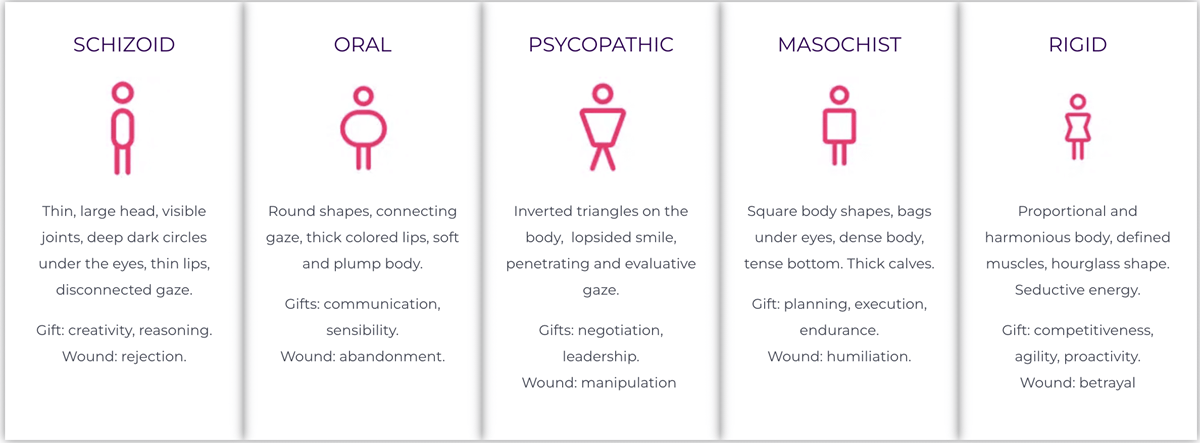Character structures are systems of characteristics of our body and mind that shape our identities, emotions, and behaviors. The character structures start developing before a child is born, in their mother’s womb, up to about 6 years of age.
In the meantime, our consciousness is struggling to interpret reality. Our thinking does not yet have the necessary complexity to understand other people’s emotions or motives, but we suffer the consequences of those interactions. That’s where the idea of trauma comes from.
However, trauma is not always an episode of violence. It happens, for example, even in the womb, when the baby feels the distress of the mother, or when the child felt abandoned as the mother returned to work just a few weeks after they were born.
No one should be blamed for these situations. Experiencing some challenges, even at such a young age, helps us better face the reality of the world.
Character structures can be “traps” in which we become stuck, repeating harmful actions, or incredible resources to become complete human beings: it all depends on the knowledge we have about the subject.
Some say that character structures are personality patterns that hide a person’s true self and they recommend one does inner work to heal or soften them.
- What are the Reichian character structures?
- Schizoid: the first character structure
- What is a person with schizoid structure like?
- How does the schizoid type behave?
- Oral: the most intense of character structures
- What is a person with the oral structure like?
- How does the oral type behave?
- Psychopathic character structure: the chameleon
- What is a person with psychopathic structure like?
- How does the psychopathic type behave?
- Masochist: a dam of feelings.
- What is a person with masochist structure like?
- How does the masochist type behave?
- Rigid: the last character structure
- What is a person with rigid structure like?
- How does the rigid type behave?
- Conclusion about character structures
- Next steps
What are the Reichian character structures?
There are five Reichian character structures: Schizoid, Oral, Psychopathic, Masochist and Rigid. The foundation of the character structures dates back to the early 20th century, during Freud’s time, based on the knowledge of Wilhelm Reich and Alexander Lowen. The five patterns develop in childhood as defense mechanisms.
It’s important to note the character structures are not the psychological disorder you may have heard about. The character structures were named decades ago and they still carry their not friendly scientific names.
Character structures have no connection to people’s morality, nor can they be seen as better or worse than others. Think of them as tools that our bodies and minds build to adapt to reality and promote a healthy emotional life!
However, this objective is not always achieved. For many people, character structures end up becoming limits. This happens when they remain unconscious, being led by the negative patterns of the structure instead of using their superpowers and gifts to their advantage.

Schizoid: the first character structure
The first character structure to develop, even during gestation, is the schizoid structure.
Many things are happening in a woman’s pregnancy. This woman may be afraid of losing the baby, or maybe this could be an unwanted pregnancy, or she might be worried the father has no job to support the family. When she experiences a stressful situation, the blood flow in the uterus decreases, and that warm and comfortable place becomes hard and uncomfortable. The baby still doesn’t know that there is a world beyond the uterus or even a mother. This baby feels that existing is uncomfortable.
To avoid the discomfort of this feeling of rejection, the baby directs the energy to the head and becomes still, disconnecting from the body and its physical sensations. At this moment, myelination is happening inside the brain, making it easier for the baby to concentrate energy in the head, ignoring the discomfort of the body.
The schizoid character structure develops as a defense mechanism to protect the baby against the rejection pain.
What is a person with schizoid structure like?
Their body is usually thinner, with elongated limbs and visible bones in several joints. It looks as the parts of their body don’t match together. They tend to live inside their mind and their feet are not well grounded. Their gaze looks “disconnected”, they seem to look through you.
If they are forced to be the center of attention or sustain unwanted physical contact, even a simple hug, they may even develop allergies and hives.
How does the schizoid type behave?
A strong schizoid character structure tends to lead to introversion and avoiding physical contact.
Feeling rejected, the schizoid in pain tends to shrink, dealing internally with fear and giving the world little more than a lost gaze.
Living in a “fantasy world” is also a striking characteristic of these individuals. Their speech and expressions are monotone because they do not always manage to translate their thoughts into words. It is quite common for them to feel strange. They might feel they are “from another planet”.
In relationships, they usually distance themselves physically, as they have difficulty interacting with others. They tend to have trouble with sexual intimacy.
They have highly developed abstract thinking and feel comfortable discussing topics of their interest.
When the schizoid accepts themselves as they are, they feel that they can exist and then begin to use all the resources of the structure such as creativity, rationality, intuition and out-of-the-box ideas, for example. To help a schizoid, you can start by respecting their boundaries. Understand and respect their decisions, so they will feel more comfortable and confident being around you and having a healthier relationship.
Oral: the most intense of character structures
The oral character structure starts developing during the breastfeeding period. At this stage, myelination descends down to the neck. Many things are happening in the baby’s environment. They experience an initial blissful attachment to the mother. It feels wonderful, like paradise.
Many things can happen: problems with breastfeeding, lack of nurturing, mother and father fighting, mother returning to work too early, mother is morning a death in the family, etc. The baby realizes the mom is not there for them anymore, or is erratic in her presence. Mom is not reliable, and they might wonder, Why isn’t she coming? or What is wrong with me? or Am I unworthy?
The chronic upset, protest and despair are too painful to live with, so the baby gives up and becomes superficially adjusted, but detached, or the complete opposite when they grow up. They will cling onto people and be very needy later on in life.
What is a person with the oral structure like?
Orals have bodies with round shapes and they always look younger than their age. They have big cheeks and needy eyes. Their big mouths were a gift from the nervous system for them to be able to communicate their needs. Their shoulders are slumped as if they’re protecting the hole in their chest. Sometimes, they even have a physical hole in the form of a collapsed chest.
Oral people feel the need to keep their mouths occupied due to the high concentration of energy in this area. They do it by talking, drinking, eating, smoking, or biting on something.
The legs of the oral can be chubby, but still visibly weak and undercharged.
How does the oral type behave?
The oral defense pattern manifests in two basic ways: collapsed and compensated. Often, a person will go back and forth between the two types. The collapsed oral usually manifests as appearing helpless, needy, clingy or lacking energy. The compensated oral may deny having any needs: “I don’t need anything from anyone.” They may act as if they can take care of themselves. This attitude prevents them from getting their needs met and confirms their belief that they will never be fulfilled.
People with predominant oral character defense can victimize themselves, be possessive and jealous, leading to emotional and financial dependence, and even dependence on the opinions of others. When they cannot find someone to rely on for this dependence, they can turn into substance abuse or excessive behaviors.
They may feel insecure, which can make them impulsive. In some cases, they may also appear selfish because they are always expecting people to do things for them.
When orals are able to meet their own needs, they feel satisfied and independent. This is extremely important to activate their resources, reaching great potential in areas such as communication, caring for others and caring for themselves. You can help an oral person by encouraging their potential. If they need to cry, just offer a friendly shoulder and show empathy.
Psychopathic character structure: the chameleon
Again, let me just remind you that the psychopathic character structure is not the medical condition psychopathy.
When the process of myelination descends a little further, the region of the chest enables control and movement of the upper body. It is at this point that the child begins to explore places by crawling, propping themselves up, and walking.
At this stage,the child is now able to move away from the mother and interact with other people. They start to walk, articulate and verbalize their needs and for that, they need to connect and convince others.
They often seek feedback on their abilities and accomplishments. Attention and acknowledgement of the child’s experience by the parents is crucial. If their deeds, curiosity and discoveries are discouraged or if they feel manipulated or betrayed, it can have negative consequences.
Being “punished” when they make a mistake and praised only when they succeed, the child may find a need to manipulate situations. Their behaviors will aim to attract more positive responses and avoid negative ones: manipulate to not be manipulated.
They may be more subtle, behaving well and trying to be good in front of her parents, for example. In other cases, the child will throw a tantrum, throw themselves on the ground, and fight to have their desires fulfilled.
What is a person with psychopathic structure like?
This person tends to have inverted triangles in their body shapes, with broad shoulders and a narrow waist. The chest may appear always puffed out, the chin is pointy and they have a lopsided smile. Their legs look like funnels, the calves are usually thin.
How does the psychopathic type behave?
Power and control are important for this character structure. As the person heals this structure, they use their gifts of seduction, leadership and negotiation to get what they want and do things for the common good. They can be great sales people or leaders. They know how to say exactly what others want to hear and they are very persuasive.
People with this defense have difficulty trusting others and often evaluate what they win and what they lose in relationships. They don’t know how to receive without feeling in debt. They prefer that other people owe them favors and things, not the other way around. The psychopath is considered a chameleon among the character structures. When they are feeling the manipulation pain, they can hide among other character structures.
Note that character structures are not good or bad, they are simply adaptations we needed to to be able to deal with the world around us.
To stimulate someone with this character structure, you should praise them on their deeds. They love being recognized. It is important that they trust you. Do not lie or deceive them, they will never forget it. Show them that they can take off their masks and be themselves with you. Understand that may they take some time to trust you.
Masochist: a dam of feelings.
The masochistic structure, also called masochistic character structure begins to develop during potty training period, when the child starts using the bathroom. Myelination descends to the lumbar region, allowing for greater use of the legs.
In many cases, the potty training process is quite premature. This causes the child to not meet the parents’ expectations: their body is not yet ready.
If the child soils their pants, for example, parents usually have a humorous behavior, but the child can feel humiliated. Thus, they will learn the hard way to contract their buttocks to avoid going through that situation again.
The defense mechanism will make this child meticulous, measuring every step. They take a long time to act and plan everything within their reach.
What is a person with masochist structure like?
The defense mechanism will make this child detail-oriented, measuring every step. They take a long time to act and plan everything within their reach. Their body becomes more square, hard, and heavy, and energy is distributed throughout all regions. Since the child felt humiliated by something they let out – whether it was physical, thoughts, words, or expressions – they decide to keep everything inside their own body. This buildup can be so overwhelming that, many times, it seems to be close to exploding. People of this structure hold things to the last straw, but sometimes they burst with anger.
Due to carrying a lot of “weight” on their shoulders, the waist is thick and square, as well as the neck. The muscles are hard and firm, just like their feet on the ground. Their gaze is friendly and gentle, but it might show suffering from holding back emotions. They may have a lamenting voice and a mouth in the shape of an inverted U
How does the masochist type behave?
Masochists endure many things, suffering so as not to make others suffer. We can say that they make a lot of effort and have little recognition, and may even feel inferior. This behavior sometimes creates an accumulation of anger. They do not allow themselves to feel, as they have difficulty expressing their feelings.
When they can no longer bear it, they end up letting everything out at once and it can be destructive, like a dam bursting.
They enjoy routine, order, and organization, and if they decide to live for more than just pleasing others, the masochists can use their resources and potentials in an incredible way.
The ability to “hold back” emotions can make them excellent planners, detail-oriented, attentive to things that no one else sees. They will also be calm and patient to execute any project.
To stimulate this person, let them know they can trust you and make sure you don’t criticize them in front of others. Activities to release all that energy through art, dance, sports, conversations, outings… any healthy habit to restore balance will help them.
Rigid: the last character structure
Finally, myelination reaches the sacral region, the genital organs, completing the character structures.
The rigid character structure begins to develop with the discovery of the child’s sexuality. The child realizes that certain areas of their body generate different sensations. Obviously, we are not talking about a “conscious” sexuality like that of an adult, only a physical sensation that does not exist in other parts of the body.
This child still has the perception that they are the most important man or woman in their parents’ lives. When they realize that their parents do not sleep with them at night, however, they experience a great confusion in their mind, which leads to a feeling of exclusion.
This structure is always formed in the relationship of the girl with the father and the boy with the mother. They create an unconscious competition for the love of the parent of the opposite sex. When we talk about father and mother, it is not necessarily the biological parents, but rather those who represent this role in the child’s life.
What is a person with rigid structure like?
The defense mechanism of this phase makes people extremely competitive, very active and with a well-defined body. Rigid individuals are very perfectionistic and usually have a more refined aesthetic taste than other character structures.
The rigid structure is very concerned with beauty and cannot stay still. They have to be doing something all the time. They often have well-defined muscles and a seductive body full of curves. Their gaze can also be seductive, and even challenging, as if saying “try to conquer me”
How does the rigid type behave?
They may struggle in relationships due to the fact that their first “love” for their parent was not reciprocated. Holding back is common, due to fear of getting hurt again.
Their internal conflict can also separate love from sexuality, giving their heart to one person and their sexuality to another. However, this does not necessarily mean that the rigid person will always cheat on their partners. In summary, character structures do not determine rules about people, only possibilities.
Betrayal only happens when the rigid character remains in their existential pain. They can be faithful, and even create an internal competition to always be better than any “threat” to their relationship.
When the rigids decide to be the best for themselves, and not to prove something to others, they can open their heart and give themselves wholeheartedly in relationships, work, and any other area of life.
To have a more harmonious relationship with this person, especially in a romantic relationship, do not let them put you in the position of the mother or father. Be partners, and show that you are there to join forces, unleashing the potential of both. Encourage them to pursue their goals with their feet on the ground, without the need to control everything!
Conclusion about character structures
In summary, it is important to emphasize that we all possess the five character defenses. Some people will be more influenced by one of them, while others will experience a balance between several.
In addition, character structures also interact with the external world to form personalities and behaviors. Two people with the same structures exhibit some similar patterns of behavior, but they are not copies of each other.
Next steps
Did you see yourself in this character structure? You can also read about the schizoid, psychopathic, masochist, and rigid character structures.
We are a mix of five character structures with different intensities. Brazilian researchers created a method to measure the percentage of each structure in individuals. After finding out your combination, you will understand what problems you’ve been facing and how to solve them. You will receive clear instructions on how to manage and soften your character structures to make better decisions.
You will learn how to use your gifts to build a happier and healthier life. Schedule your free discovery session now.






